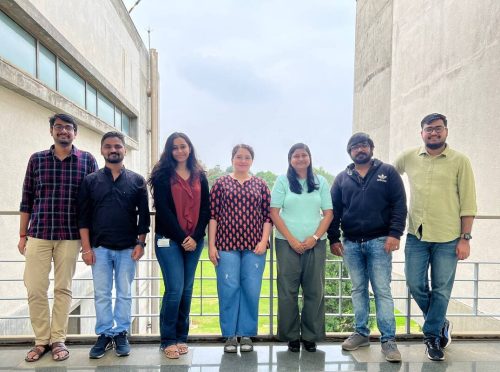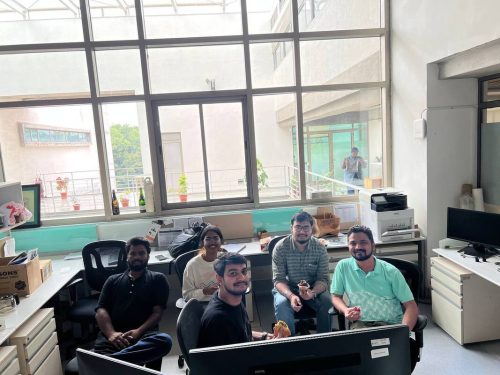Lab meeting with the Das lab
Posted by the Node, on 17 January 2025
This is part of the ‘Lab meeting’ series featuring developmental and stem cell biology labs around the world.
Where is the lab?
The lab is located at National Centre for Biological Sciences, Tata Institute for Fundamental Research, Bangalore, India.
Lab website: https://daslaboratory.weebly.com

Research summary
Soumya Das: Ischemic heart disease (IHD) is the number one killer world-wide and in India. IHD is primarily caused by coronary occlusions. Most patients are ineligible to undergo the invasive treatments (like stenting, coronary bypass surgeries) for IHD. An alternate is to create artery to artery connections called collateral arteries which can perfuse tissue downstream of an occluded artery. Our group investigates cellular mechanisms, molecular drivers and physiological triggers which facilitate the de novo formation of collaterals. Using mouse genetics, single cell RNA sequencing analyses and whole heart confocal imaging at single cell resolution, we show that young mouse artery cells can de-differentiate and proliferate in response to myocardial infarction, a phenomenon absent in older hearts. Additionally, combining genetic lineage labeling/tracing with in vivo live imaging of mouse embryos, we show that artery cells extend on pre-determined microvascular tracks to build pial collaterals in brain. Our study reveals that Vegf/VegfR2 axis facilitates pial artery-tip extensions in the developing brain, but drives coronary proliferation in injured hearts. Thus, while developmental pathways reactivate in response to injury, their mode of action may be distinct. Together, our work suggests organ-specific mechanisms drive collateral formation in the heart and brain.
Currently, we are identifying other molecules and physiological factors which tune the process of collateral making. We are also exploring the relevance of multiple (cellular) processes to create these collaterals, and what is the impact on overall organ function.
Lab roll call
Bhavnesh Bishnoi (2021-present) is a graduate student investigating the biochemical contribution of cardiac cells towards coronary artery development and collateral formation. He is the first graduate student of the young Das lab at NCBS.
Swarnadip Ghosh (2022-present) is a graduate student who is exploring the mechanisms underlying collateral development in the brain. He is also interested in the mechanobiology of vessels. He was a critical part of the recent study (Kumar et al., Cell Reports, 2024) describing the cellular and molecular regulation of pial collaterals in development and homeostasis.
Ravindra Kailasrao Zirmire (2023- present) is a postdoctoral fellow interested in uncovering the role of artery cell proliferation in coronary collateral vessel formation and its effect on cardiac regeneration. He is also interested in parsing out the details of inflammation-mediated cardiac fibrosis, and the role of vasculature in the process.
Alfia Nirguni Saini (2024- present) is a graduate student who focuses on developing tools to study Artery Reassembly in vitro. She also wants to capture ischemia-driven (and specific) artery cell behavior, which significantly contributes to collateral formation in an injured mouse heart.
Zidhan Subair (2024- present) is a project associate interested in using microfluidics to study blood-flow induced mechanosensory pathways in cardiovascular remodeling.
JerushaEmanuel (2025- present) is a graduate student who just joined the lab and wants to explore if and how cellular interactions between vascular and non-vascular cells facilitate collateral formation in the heart and brain.
Over the past few years we also had a postdoctoral fellow, few Masters thesis students and some interns who were a delight to work with.

Favorite technique, and why?
Soumya: We like to not limit ourselves to a single technique, and develop them as and when needed. That being said, a significant amount of our work is primarily driven by mouse genetics and microscopy. We have developed ways to perform whole organ imaging at cellular and sub-cellular resolution, in fixed and live tissues. This has allowed us to capture the cellular dynamics of endothelial cells during embryogenesis, adulthood, and in diseased states. Together, we now probe deeper questions which seemed unapproachable earlier.
Apart from your own research, what are you most excited about in developmental and stem cell biology?
Soumya: What intrigues me most is the genetic variation that exists within the genome of a population─ how did it come to place, and how has it evolved over time. This eventually reflects on various measurable observations, and I wonder if we can predict the evolutionary trajectory learning from these changes in structures and functions.
How do you approach managing your group and all the different tasks required in your job?
Soumya: I am lucky that there is not much to be “managed”. My young team at NCBS, (though small) is extremely driven, smart and efficient. At NCBS, students and postdocs run the lab─from procurement of lab equipment/consumables to steering their projects. I meet with each member of my team individually, to discuss “raw” data, every couple of weeks, and sometimes multiple times within the same week, or even a day. This happens on a need basis. We have weekly lab meetings where one team member would present their analyzed data. This is to give everyone a bigger picture, brainstorm ideas and decide on the next logical step of experimentation. We also have weekly journal clubs where we discuss a unique discovery or novel technology. Apart from these interactions, everyone is welcome to stop by my office and have a conversation if and when needed. Additionally, everyone is encouraged to participate in meetings and conferences and science competitions. The other (significant) aspects of being a PI in academia is procuring funds, editing/reviewing manuscripts, and performing administrative duties.
What is the best thing about where you work?
Soumya: What I like most about working with my team at NCBS is the freedom to do the science I want to do and pursue the questions that intrigue me. One of the best feature of NCBS is the on-campus creche (Dolna), which is a life-saver to all parents working at NCBS. We are able to give our 100% to science because we know our little ones are happy and safe at Dolna.
Bhavnesh Bishnoi: The opportunity to explore new ideas, engage with diverse scientific fields, and discuss research with the community are some of the greatest aspects of NCBS.
Swarnadip Ghosh: The best part about NCBS is the technical support we get for our research work. The staff is very sincere, the environment is extremely supportive and student-friendly.
Ravindra Kailasrao Zirmire: The freedom to pursue an idea even if it is exploratory and seems out-of-the-box.
Alfia Nirguni Saini: The access to many instruments and devices to do experiments and of course the collaborative atmosphere.
Zidhan Subair: The best part of being at NCBS is the support and freedom to pursue projects that truly excite me. There is always an opportunity to learn, and the NCBS community is always willing to assist with both technical and academic matters.
JerushaEmanuel: I love that NCBS has a diverse scientific community, not a day goes by without us learning something new. Interacting with people who are excited about science inspires me. The campus being gorgeous and having many cafeterias is a major plus.

What’s there to do outside of the lab?
Soumya: As a team, we occasionally go out for lunches or dinners. We try to celebrate every big or small victory with chai and samosas in one of the many cafes on campus─be it an acceptance of a manuscript or a student passing their comprehensive (qualifying) exam. Most of us spend their weekends with family and friends. I like spending time with my 2 years old daughter, I am currently learning gardening skills and over the weekend, I like to gettogether and relax with close family and friends.
Bhavnesh Bishnoi: What I enjoy most outside the lab is watching movies and taking long walks in nature.
Swarnadip Ghosh: Outside the lab, in the afternoon, the lab goes for tea, spends time and discuss about science and non-science matters. We also often go for swimming and play indoor games.
Ravindra Kailasrao Zirmire: Outside of the lab, I like swimming, listening to music and learning and brainstorming about entrepreneurship ideas.
Alfia Nirguni Saini: There’s so much greenery outside the lab and many places to sit and chat with lab mates and friends. It helps me unwind after a long day.
Zidhan Subair: Outside the lab, I love reading, exploring the open road, and discovering new restaurants around town.
JerushaEmanuel: When not in the lab, I like going on long walks, playing the piano and singing. There’s a ton of extracurricular activities on campus─from movie screenings to concerts. I enjoy being a part of them occasionally.


 (6 votes)
(6 votes)